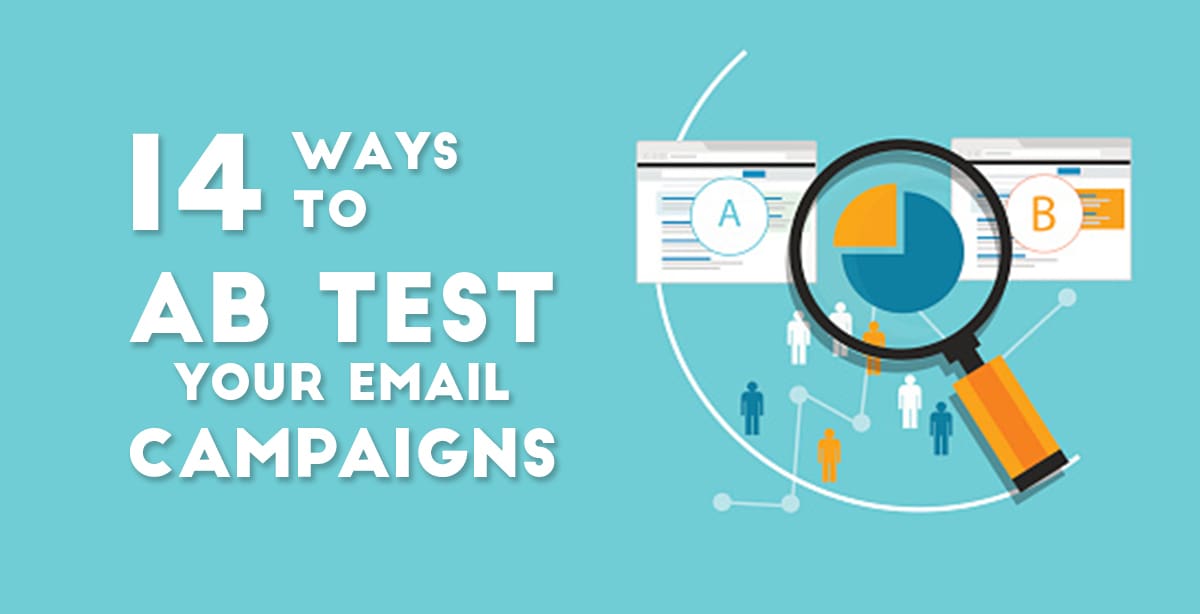
Do you want to make sure you are sending out your emails at the right time, with the most engaging content and the most enticing subject lines? Of course you do! And you can achieve this by AB Testing. Also known as “Split Testing,” AB Testing is one of the best ways to make sure your email marketing campaigns are performing at their maximum potential.
What is AB Testing?
For those who are not familiar, AB Testing is a method of sending two versions of an email in order to test them against each other and determine which performs better. Each version of the email is typically sent to a portion of the recipient list. Sometime after the initial test emails are sent, a winner is determined based on a tracked metric (open rate, click rate, etc.) and that email is then sent to the rest of the list.
“AB Testing is essentially an experiment where two or more variants of a page are shown to users at random, and statistical analysis is used to determine which variation performs better for a given conversion goal.” – Optimizely
So why should you AB test?
AB Testing also gives you the chance to be creative with your campaigns and try something new. Testing these new ideas against your standard templates, content, or send times gives you a side-by-side comparison of what actually performs better.
Not only does AB Testing give you the chance to be creative, it also backs your creativity with data. AB Testing provides powerful insights and data so you can optimize your campaigns for maximum engagement and increase your ROI. These insights help you learn about what resonates with your audience and gives direction for future email sends. In short, AB Testing provides the data to prove which ideas work and which don’t.
14 Ways to AB Test Your Emails
Testing Send Times
1. Time of Day
A good place to start with AB Testing is send time. Finding the perfect time of day to send emails ensures your emails arrive at the right time for your recipients. Of course, not all recipients are checking their inboxes at the same time, but you can use this test to determine when the most are.
While testing variables, you will want to track the open rate of your campaigns, the metric most likely to be affected. After running your test, you can determine the send time with the highest open rate. That’s the winner. This is also a good test to run multiple times, testing different times throughout the day.
2. Send Day
I’m sure you’ve heard the email marketing commandment of only sending emails on Tuesday and Thursday. While that used to be the case, it’s not anymore. With our world more connected than ever, and more people accessing email on their phones, inboxes are opened seven days a week.
Just like testing time of day, you will want to track the open rate of your send day test. Try testing with multiple days, and don’t be afraid to send on the weekends! When you find the best performing day, stick to a schedule using that day. This way your subscribers will be expecting to receive emails on the same day.
Testing Subject Lines
One of the most popular AB tests to run for email marketing is testing the subject line. This may be because the subject line field is easy to edit. There are also many different variables and tweaks you can test with your subject line. Because of this, you want to make sure you have strategic reasoning for your test, rather than testing two random subject lines. Some examples of subject line tests include:
1. Emojis
Using emojis in your subject lines is one of the most common AB Tests out there. Depending on your audience and subject matter, this can help increase the open rate of your email campaigns. For example, if you are a fun clothing brand, emojis may work with your brand voice and appeal to your audience. However, if you are a more traditional B2B brand emojis may not work as well. That being said, you never know until you test!
2. CTAs
Using CTAs in your subject line such as “Shop Now” or “Save Today” can be a good way to test your subject line and optimize the open rate of your emails. While this may entice some users to open, it could also be seen as too salesy by other users and they may not click.
3. Dollars VS Percentages
If you are an e-commerce brand and are running a sale you can test which offer is more enticing to your users when it comes to the savings”dollar amounts or percentages. Results for this test may vary based on the specific offer, but AB Testing will always give you the best result.
4. Personalization
Today’s consumers are expecting brands to know who they are and to build a connection with them. Personalization is a great way to do this. You can test using individual subscriber names or any other information you have collected from them.
Testing “From” Names
Another variable that is easy to test in your email is the “from” name. This can include both the sender’s display name and the sender’s email address. Examples of “from” name testing include:
1. Company VS Individual
Depending on your business and what you are promoting, you can test an individual’s name in the company against the company name. This could be the owner, CEO, or whoever else in the organization the content is coming from.
2. Company VS Sales
If you are an e-commerce business you can test your company name versus a “sale name.” These sale names could include “Company Name Sale,” “Company Name Outlet,” “Company Name Bargain Bin,” etc. There is room to get creative with this one.
3. Generic VS Personal Email Address
You can also test the email address this is coming from. You can use an individual’s email address against the generic company email address you typically send from.
Testing Email Content
The final variable to test in your email marketing campaigns is the content of the email. This can cover text, design, images, and more. Some great content ideas to kick-off your email AB Testing strategy are:
1. GIFs VS Static Images
GIFs have become very popular across the digital world in the last decade. While not all email clients support them, those that do will bring some life to your email. You can test using different GIFs in your email to see which are more engaging for your audience. But be careful using too many GIFs in email, as file sizes can be much larger than images, and can thus effect load times.
2. Lifestyle Images VS Product Images
If you are promoting a product or a variety of products in your email you can test the imagery. Which photos speak to your audience? Product photos? Or lifestyle photos of the product in-use? Be sure to test to see what appeals to your subscribers.
3. CTA Button Placement
Something as small as the button placement can have a big impact on the performance of your email campaign. If your button is buried under a lot of content and you find that your click-through rate is lower than expected, try moving the button closer to the top of the email and run a test against your current layout.
4. Layouts
Email marketing designs tend to be repetitive using a similar layout for most sends. Because of this, companies and marketers may be inspired to design a new layout to use for their campaigns. If you find yourself in this situation, be sure to run an AB Test, testing the new template against the old. If the old outperforms the new you can tweak your new template and try again. If the old template is still coming out on top, you may have found out your subscribers do not feel it is dated or repetitive at all.
5. Copy
There is a lot that can be tested in email copy. You can test a long and detailed intro section against a short and concise section. Or perhaps you are looking to test out a new brand voice. AB Testing an email is the perfect opportunity to do so. You can also use different verbiage for CTA’s, promo offers, and more.
With many of these tests, you will find that creativity is key. This is not a complete list, of course, but it will help spark some inspiration. The biggest thing I can stress is, if you have a new idea for your email campaigns, test it against what you are currently doing. If it is not successful, think about how you can tweak it and test it again. As our subscriber’s behavior, as well as the digital landscape, are ever-changing, AB Testing is a continuous cycle.
Tips for Running a Successful AB Test for Email
As a final note on AB Testing, here are some tips that will help you achieve success in testing and optimizing your email campaigns.
- Test one variable at a time. Make sure you are only changing one variable in your test so you know exactly what caused the change in behavior.
- Keep on testing. AB Test as much as possible. Also be sure to run the same test on multiple campaigns. Do not think that the winner of your first test is what you should go with.
- Track the right metrics. Make sure the metric you are tracking can be affected by your test. For example, if you are testing CTA button placement in the content of the email, you would not want to track the open rate, as subscribers will not be exposed to the test before opening. You are better off tracking click-through rate or revenue.
- Record your results. The simplest way to do this is by using a spreadsheet. Track what you are testing and the outcome of that test. This will help when implementing decisions from your AB Tests.
- Listen to the data. AB Testing will show you what your audience is engaging with and what they want to see from your campaigns. You may not always agree or like the design, subject line, etc., but if it works for your subscribers you should use it.
AB Testing is a crucial step to take in your email marketing strategy. Could you use a hand creating and implementing tests? At The Brandon Agency, our fully integrated marketing firm with offices in Charleston, Charlotte, and Myrtle Beach, boasts a team of email marketing specialists who can cover all aspects of your AB Testing strategy. To get started with help, ranging from a simple marketing analysis to a comprehensive strategy tailored to boost the performance of all of your email marketing efforts, contact us today.
By subscribing to our newsletter, you agree to our Privacy Policy.




